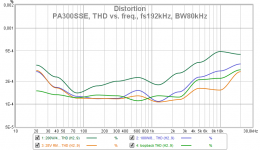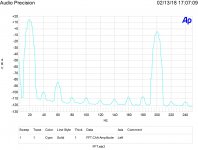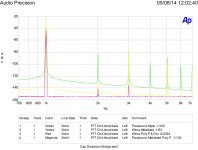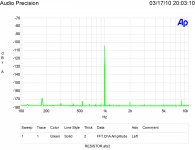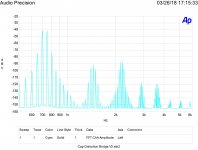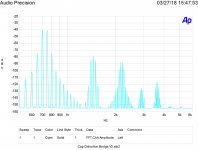Oh yes? And who assesses that and how? Is it like when Mark and Richard assess one another and the sound and find they agree?Subjective assessments have a value depending on the knowledge and serious of the guy that report them.
You, for yourself.Oh yes? And who assesses that and how?
Exactly. And, as I often have the same experiences, I tend to read their inputs with interest.Is it like when Mark and Richard assess one another and the sound and find they agree?
Not saying that I "believe blind". If they indicate something that I can try, i will verify by myself.
Seriously consider bi- or tri- amping. Get rid of speaker cables and power crossovers. They are always riddled with compromises...
Yes, I’m trying to figure out a better mousetrap for the dsp end of things, looking like a mini dsp shd is in the lead.
Already have a crown xls 2002 for subs, gonna run the 10” drivers with the my yammie. And the Hint has a HT bypass so I can run the tweets from that (should stay in class A for the most part!)
So except for a cap on each tweet it’ll be all active.
I wouldn’t be able to integrate my current equipment without the dreaded speaker cable but I’ve got some decent belden/cardas stuff matched to each component. (All off the spool so no panic!)
Last edited:
As I wrote, no load at otput. Just to show "capacitor distortions"..With load it looks like this, in picture is also no load measurement and card loopback.Impressive! Into what load?
Attachments
Last edited:
WHo is trying to argue ?You've heard the same sound as them? I must have missed those sound files
It is very simple. When a sound engineer that i admire the work told me that some gear is very good for something, I it give-me the desire to test-it because I trust his "taste" is close to mine.
We most of all listen to the same records, and I usually understand what people are looking for, and have an idea if it is the same things than me.
In studios, we don't have lot of difficulties to share our feelings with various musicians and producers.
From Earl's post I linked to earlier:
"So what is one to do? Only by understanding how objective data ("hearing with your eyes") relates to what we (as a group) actually perceive can one narrow down on what matters and what doesn't and what needs fixing and how"
The salient point here, to my mind is, "what we as a group actually perceive". Our hearing has evolved to aid survival, not to be fooled by reproduced sound in our rooms.
"So what is one to do? Only by understanding how objective data ("hearing with your eyes") relates to what we (as a group) actually perceive can one narrow down on what matters and what doesn't and what needs fixing and how"
The salient point here, to my mind is, "what we as a group actually perceive". Our hearing has evolved to aid survival, not to be fooled by reproduced sound in our rooms.
?
For once, you surprise me, Simon. Can you develop? On the paper, mikes are better than speakers, and preamps than power amps.
Microphones are better than loudspeakers, that is no the issue. When you record a sound there are room interactions, positional differences and source directional differences.
If I listen to just a person talking in a room the high frequencies are more directional and some low frequencies will still reach me due to reflective surfaces.
If I record that person in a studio the microphone does not have the same coverage angle as my ears and often the room has less or no reflections.
Thus even playing back the recording in a room will not sound the same as some information has been lost.
This gets much more complex with multiple microphones, other types of sources and of course recording technique.
In a recording when the talker mumbles so as to be hard to understand, a recording with a closer microphone and skilled operator may actually make understanding much easier. So it is really not an accurate representation of the live experience. (Better perhaps!)
Another great post by someone who probably knows what they're talking about https://www.diyaudio.com/forums/mul...eaker-time-phase-coherent-14.html#post5999178
I have exchanged with Richard and Mark. Listened to the earl's speakers.That makes some sense because you have heard the sound he has created and have access to the same gear, how do you go about assessing Earl, Richard or Mark?
About Earl, i dislike the way he address the "HOMs". To my ears, the foam he use kill more life that distortions. As I do not notice any annoying distortion in my own horn based system, at the level I listen, this is, for me, a solution to a non existent problem. May-be those HOMS were created by its wave guides as often created by most of the usual horns. Here it is another kind of abusive generalisations. What people reproched to horns w is not due, AFAIK, to the horn theory, but the fact they were wrongly designed and realised. (Bad expansion curves, too much resonances in the material used.
I prefer Spherical waves horns (Le clea'ch like) than any kind of waves guides.
I dislike his choices of poor horn drivers, pretending that they have very little influence. It contradict my own experiences when I was studying those kind of speakers (measured, listened a lot of drivers). And, if the ones I use in my home were too expensive to my taste(JBL) it is not snobbism, I dislike expensive parts.
NADs, highly estimated in the audiophile and pro world, were immediately rejected on both the measures and the listenings.
I dislike its multiple subs theory. It is true that they address room's resonances modes. But they kill the impact that can give a big speaker in front of you. There is better way to address the room resonances in low frequencies (Bass traps etc.)
I agree with a lot of other things he says.
Just my opinion, once more. My speakers have a very flat (slowly descending on purpose) response curve, very good group delay, high efficiency, low measured distortions. They are not perfect neither, and those measurements don't say a lot about the nice way they sound or their defects.
Last edited:
Quote:
Originally Posted by simon7000
If I understand your comment correctly the Boltzmann constant noise shows up as 1/F noise. Possibly another good argument for a DC compensation servo.
No, it is very different from 1/f noise, it is the equivalent of thermal noise in resistors, and decreases with admittance. So large caps like used for coupling generate very little noise. It shorts the thermal noise generated by the input resistance, so that the resulting noise is mainly determined by the source.
As I see it that has frequency tilt and thus behaves more like 1/F noise.
As the capacitor is in series with the source it can only lower the input source impedance to that limit.
Quote:
Originally Posted by simon7000 View Post
The standards have suggested an input impedance of 10,000 ohms for consumer gear last I looked. Pro gear is of course 600 ohms. (Not really, an obsolete standard.)
Yes, but there is no reason to have this internal in a piece of gear. But at the interface to the outside world it does. The reason as I see it is that live connections are dangerous to be made with gear with high input impedance. DC bombs and RFI on connecting cables come to mind.
Internal to the gear you would not be limited by the standards. So we agree here.
Quote:
Originally Posted by simon7000 View Post
Higher impedances are more susceptible to picking up stray noise. The other issue is you frequently want the input bias current multiplied by the input resistor to equal the input offset voltage.
Yes, but only if they are not properly terminated. The moment a high impedance input is connected to a lower source impedance, the source impedance dominates and determines the noise level.
Not really there is what we can call capacitive coupling to the noise source which can be reduced by source impedance if low frequency enough where the connecting cable is not acting as an antenna and magnetically coupled noise which would be increased by lower source impedance.
Quote:
Originally Posted by simon7000 View Post
Even with no signal voltage across a component if it is passing current, it might distort the current. Some folks consider the basic elements of circuit theory R, L, C and D!
Noooooo!!!!
There has to be a voltage over a component, or there will be no distortion. This is basic understanding. The input cap and the input resistance form a voltage divider. If there is no voltage over the cap, only the resistor can contribute to distortion. Every distortion necessitates a voltage differential between input and output of the component (either it will generate one or it just won't be there).
Yes there are many components that do not follow ohm's law. It is possible to have negative resistance! So that a decrease in current can maintain the same voltage drop. Of course all real components will have some voltage drop when carrying any current.
Quote:
Originally Posted by simon7000 View Post
Now as there is never absolutely no voltage across the capacitor but rather a frequency dependent one there can be intermodulation distortion at usually a very low level from the behavior of the insulator. In a loudspeaker crossover this can be mechanically induced.
There is indeed always a voltage across a real life capacitor. Nothing at room temperature will conduct current without developing a voltage over the two terminals. The larger the value of the cap, the lower this voltage. Think in terms of the voltage divider described above. Take a large cap and a large input resistance. There will be little voltage over the capacitor, even at low frequencies.
If the current varies in the capacitor that will show up as distortion in the resistor. This can be caused by vibration. The effects on the dielectric caused by a complex signal can also cause distortion but usually at low levels. That is why some find higher voltage rated capacitors of the same type have lower distortion.
Quote:
Originally Posted by simon7000 View Post
Resistors can be very good, capacitors are not quite as good and mis-selected can be bad. Inductors are generally the component that least matches circuit theory. However we have to use what exists.
Good or not quite as good, in what terms?
Resistors may have distortion contribution 160 dB below the signal level, good capacitors may be 130 db below the signal level. Inductors don't get near that even for small signals. Attached are my measurments on capacitors and a good resistor.
Quote:
Originally Posted by simon7000 View Post
As Demian pointed out there can be multiple capacitors in series. As their distortion mechanisms may match the distortion can add. So with 10 capacitors in series the distorton instead of being -120 dB down may be only -100 dB.
A well proportioned coupling cap does not distort.
All parts distort, the question is how much in their application.
If you hold your mouse over the thumbnail the ID will show.
Originally Posted by simon7000
If I understand your comment correctly the Boltzmann constant noise shows up as 1/F noise. Possibly another good argument for a DC compensation servo.
No, it is very different from 1/f noise, it is the equivalent of thermal noise in resistors, and decreases with admittance. So large caps like used for coupling generate very little noise. It shorts the thermal noise generated by the input resistance, so that the resulting noise is mainly determined by the source.
As I see it that has frequency tilt and thus behaves more like 1/F noise.
As the capacitor is in series with the source it can only lower the input source impedance to that limit.
Quote:
Originally Posted by simon7000 View Post
The standards have suggested an input impedance of 10,000 ohms for consumer gear last I looked. Pro gear is of course 600 ohms. (Not really, an obsolete standard.)
Yes, but there is no reason to have this internal in a piece of gear. But at the interface to the outside world it does. The reason as I see it is that live connections are dangerous to be made with gear with high input impedance. DC bombs and RFI on connecting cables come to mind.
Internal to the gear you would not be limited by the standards. So we agree here.
Quote:
Originally Posted by simon7000 View Post
Higher impedances are more susceptible to picking up stray noise. The other issue is you frequently want the input bias current multiplied by the input resistor to equal the input offset voltage.
Yes, but only if they are not properly terminated. The moment a high impedance input is connected to a lower source impedance, the source impedance dominates and determines the noise level.
Not really there is what we can call capacitive coupling to the noise source which can be reduced by source impedance if low frequency enough where the connecting cable is not acting as an antenna and magnetically coupled noise which would be increased by lower source impedance.
Quote:
Originally Posted by simon7000 View Post
Even with no signal voltage across a component if it is passing current, it might distort the current. Some folks consider the basic elements of circuit theory R, L, C and D!
Noooooo!!!!
There has to be a voltage over a component, or there will be no distortion. This is basic understanding. The input cap and the input resistance form a voltage divider. If there is no voltage over the cap, only the resistor can contribute to distortion. Every distortion necessitates a voltage differential between input and output of the component (either it will generate one or it just won't be there).
Yes there are many components that do not follow ohm's law. It is possible to have negative resistance! So that a decrease in current can maintain the same voltage drop. Of course all real components will have some voltage drop when carrying any current.
Quote:
Originally Posted by simon7000 View Post
Now as there is never absolutely no voltage across the capacitor but rather a frequency dependent one there can be intermodulation distortion at usually a very low level from the behavior of the insulator. In a loudspeaker crossover this can be mechanically induced.
There is indeed always a voltage across a real life capacitor. Nothing at room temperature will conduct current without developing a voltage over the two terminals. The larger the value of the cap, the lower this voltage. Think in terms of the voltage divider described above. Take a large cap and a large input resistance. There will be little voltage over the capacitor, even at low frequencies.
If the current varies in the capacitor that will show up as distortion in the resistor. This can be caused by vibration. The effects on the dielectric caused by a complex signal can also cause distortion but usually at low levels. That is why some find higher voltage rated capacitors of the same type have lower distortion.
Quote:
Originally Posted by simon7000 View Post
Resistors can be very good, capacitors are not quite as good and mis-selected can be bad. Inductors are generally the component that least matches circuit theory. However we have to use what exists.
Good or not quite as good, in what terms?
Resistors may have distortion contribution 160 dB below the signal level, good capacitors may be 130 db below the signal level. Inductors don't get near that even for small signals. Attached are my measurments on capacitors and a good resistor.
Quote:
Originally Posted by simon7000 View Post
As Demian pointed out there can be multiple capacitors in series. As their distortion mechanisms may match the distortion can add. So with 10 capacitors in series the distorton instead of being -120 dB down may be only -100 dB.
A well proportioned coupling cap does not distort.
All parts distort, the question is how much in their application.
If you hold your mouse over the thumbnail the ID will show.
Attachments
Last edited:
Or the question could be to be sure that harmonic distortion is the main flaw in action. It seems to me that electrolytics flaws are more situated on transients. Like some kind of instant limiter, if you see what I mean. I would like to see a bit-bit comparison with good musical signals (Acoustic guitar, drums kit, percussions).As Demian pointed out there can be multiple capacitors in series. As their distortion mechanisms may match the distortion can add. So with 10 capacitors in series the distorton instead of being -120 dB down may be only -100 dB.
A well proportioned coupling cap does not distort.
All parts distort, the question is how much in their application.
I dislike its multiple subs theory. It is true that they address room's resonances modes. But they kill the impact that can give a big speaker in front of you. There is better way to address the room resonances in low frequencies (Bass traps etc.)
I believe it's to address smooth bass over large area in a small room, effective bass traps would possibly be too large. He advocates using them with full range speakers without a HP filter, ie, you still have a big speaker in front of you. I can't comment on horns as I have no experience of them, they do seem to have their own problems though judging by all the thread discussions, I can imagine their visual impact has quite an effect on the perceived sound
Last edited:
You dislike a smooth response, maybe? I said the same thing after building a damped cabinet. At that point I didn't know what the underlying problem was or how to fix it. I even tried going back and building a new resonant cabinet, but did not succeed.But they kill the impact
Yes.You dislike a smooth response, maybe? I said the same thing after building a damped cabinet. At that point I didn't know what the underlying problem was or how to fix it. I even tried going back and building a new resonant cabinet, but did not succeed.
i will send-you a PM. May-be i have to tip to help-you ;-)
Sure, for audio. What about the criteria for judging the quality of audio reproduction?Its audio, guy.
Make your "own preference" by listening. My comment has only the interest to point your attention on some details about sound characters.
You make a lot of incorrect personal assumptions about members here, please put me back on your ignore list.
Scott, I don't know about you but I miss the good old days.I'm pissed-off of this aggressivity and this lack of tolerance. Tried to calm down the ambiance, get that kind of STUPID reaction. I join the long list of those who, before me, reacted the same way, harassed by the same few people: Goodbye.
- Status
- Not open for further replies.
- Home
- Member Areas
- The Lounge
- John Curl's Blowtorch preamplifier part III
